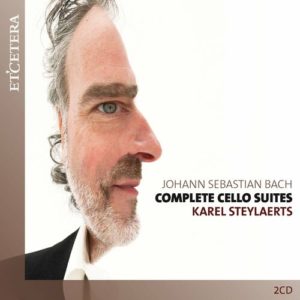
Karel Steylaerts. Bach Cello Suites. EtCetera CD. KTC1766. Released 2022.
Recorded 13-17th July 2020.
Venue Sint Hilariuskerk te Mullem Belgium.
Cello played, made by Lorenzo Ventapane Naplels 1835
Introduction.
This recording is an example of something positive emerging from the Covid lock down period. As we all know, live performance completely disappeared from the agenda bar some live streams. However, many enterprising artists seized the opportunity to divert their attentions onto projects that would likely have never been possible due to time constraints. This performance is one such example. I would venture to predict that history will reveal a short golden period of creativity at this time, if this CD is anything to go by!
The Cellist.
Karel Steylaerts hails from Belgium with his musical education moving to Cologne after initial time at the Brussels Conservatoire. His teachers include Maria Kliegel. Steylaert’s career includes much chamber work and a period as principal cellist of the Brussels Philharmonic. His recorded work includes that played on period instruments.
For this recording Steylaerts plays on a cello with modern set up.
The Recording.
This is an excellent recording with typical Church acoustic. The sound is very reminiscent of the Queyras recording in that there is ample reverberation. In this case the producer and engineer have managed to control the unwanted echoes. The end result is a very pleasing sound stage to flatter your sound system without adding unwanted breathing and finger board noises. At times, I am still reminded of the echoes generated in the London underground but it does not intrude into the enjoyment of this performance.
The sound of the cello and performer is well balanced with ample lower end emphasis, and top end smoothness.
The music.
This is what I term a typical hybrid recording. The sound is unmistakably modern with steel strings and modern bow. However, the use of vibrato appears very restrained, and the tone is unforced. The features I enjoy of period performances, such as the steady ebb and flow of phrasing, clear rhythm and sense of momentum are all here.
The speeds chosen are all very conventional without extremes of speed or slowness. There is modest give and take in the timing, good use of dynamics and some variation in the cello voice. By voice I mean contrast of character between sweet and tender with strong and aggressive.
I initially listened to this via streaming as a way of “vetting” new recordings before spending money! Via this mode it immediately grips, so I had no hesitation in buying the CD!
This recording is one of a select number which compels me to keep listening to the end. I was able to focus closely on the music without temptation to check emails etc!
Polyphony.
Having listened a couple of times to the complete recordings, my conclusion is that the distinctive feature of this performance is the ability to draw out the polyphony of Bach’s writing. As I listen I can easily imagine two or more players in front of me. The bass “continuo” parts are very well defined to intertwine with the higher melody parts. The notes of the fast passages are balanced to complement these two parts.
It is clear this feature of the recording has not arisen from innate and instinctive musicality alone. The CD notes quote a cellist called Hushoff:
“When we listen to a monodic polyphonic work, the perceived line of an instrumental voice created at a particular moment temporarily enters our consciousness. If this voice is not continued and another enters our perception, the first voice becomes imaginary: It continues to exist, but does so beyond the realm of reality. That voice’s line must now be continued by the subconscious (of the listener)”.
This, I believe gives a clue as to the seductiveness of this piece of music. It truly involves the listener to be part of the performance rather than a passive entity.
Not just phrasing.
In my opinion, Steylaerts more than any other cellist has communicated this aspect of Bach’s music. It is more that subtle phrasing which many cellists accomplish very ably. I suspect it is to do with a combination of phrasing and microseconds of timing variation that achieve the end results. In developing this, the performer has clearly employed his time from enforced restriction of activity in lockdown well. Of course, intrinsic musicality is a vital essence!
I note also from the CD leaflet that Steylaerts is accustomed to providing cello continuo to competitors performing in period music events. The role of continuo player is far more than that of providing accompaniment. It is a vital driving force of the whole piece and a specialism in itself.
A brief closer look.
This recording is consistently good in my view. I will just mention one section that merits special comment. That is the fourth Prelude. This is one of the most varied movements in style, pace and phrasing when comparing one recording with another. Steylaerts, uses a brisk pace but unlike many does not land heavily on the bottom note of each bar. What he does which I have not been aware of in any other recording is alternate every two bars between detached notes and more legato bowing. I suspect there is little historical basis for this but it certainly adds interest. Furthermore, for me it underlines the thought put into this performance.
Conclusion.
This has leapt into my top five recommendations. The performance is technically accomplished, musically seductive and opens new insights to me as a listener. Highly recommended.
Charles.